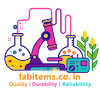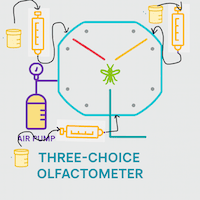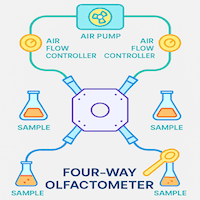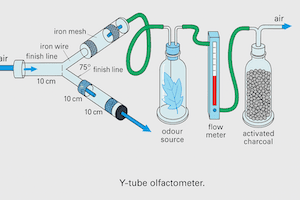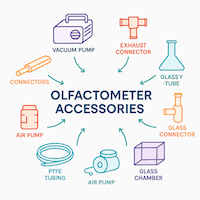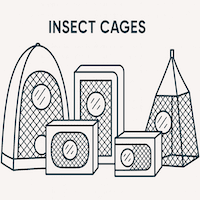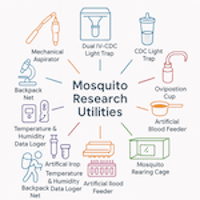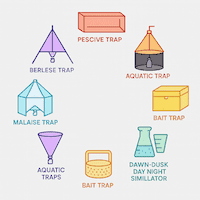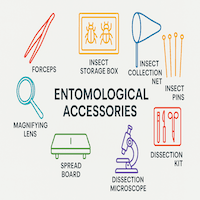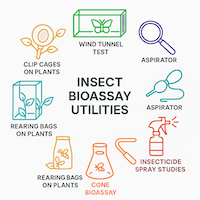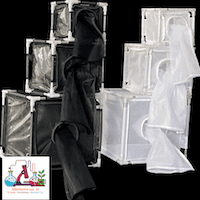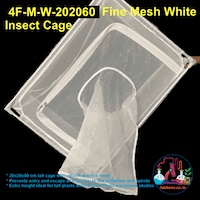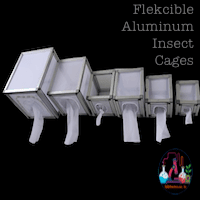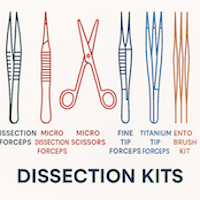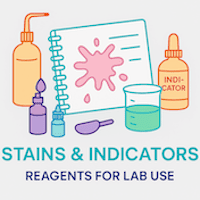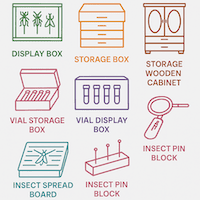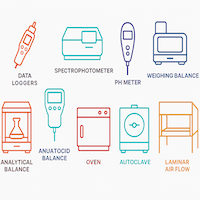Study of Insect responses to semio-chemicals using insect olfactometer
Importance of studying insect responses
The Role of Insect Olfactometer
Application areas for the use of insect olfactometer
Pest Management: Understanding how pests respond to semiochemicals can lead to the development of more effective and sustainable pest control strategies. For instance, by identifying attractants or repellents, we can design environmentally friendly methods to manage agricultural pests, reducing the need for chemical pesticides. Similarly, attractants and repellents of mosquitoes can be studied and can be analyzed various optimum concentrations for an effective repellency or attractant.
Conservation Biology: Insect responses to semiochemicals are essential in conservation efforts, particularly for endangered species. Olfactometers help researchers design traps or lures to monitor and protect these species.
Behavioral Ecology: Studying insect responses contributes to our understanding of insect behavior, helping researchers decipher mating patterns, foraging behavior, and territoriality.
Semiochemicals: The Language of Insects
Semiochemicals are chemical substances that convey information between individuals of the same species (intraspecific) or between different species (interspecific). They can be broadly categorized into two main types:
Pheromones: Intraspecific semiochemicals that facilitate communication within a species. Pheromones can be further classified into sex pheromones, aggregation pheromones, and alarm pheromones, among others.
Kairomones: Interspecific semiochemicals that benefit the receiver while harming the emitter. Kairomones are often used by predators or parasitoids to locate their prey.
Understanding how insects perceive and respond to these semiochemicals is of paramount importance for various practical applications, including pest management, agriculture, and conservation efforts.
The design and functionality of insect olfactometer
Olfactometers consist of several key components:
Provides a controlled stream of air through a stimulus chamber and a control chamber, allowing for the delivery of odor stimuli to the test insects. The use of an air delivery system in an insect olfactometer is pivotal in understanding the intricacies of insect olfactory behavior. Olfactometers are instruments that provide a controlled environment to study how insects respond to specific odor stimuli. At the core of this device is the air delivery system, which ensures the even and precise distribution of these odor stimuli. The controlled air stream functions both to disseminate the odorant and to motivate insects to move, typically between choice arenas where they can decide to move toward or away from a given odor.
Within the confines of the olfactometer, the air delivery system often comprises an air pump or a similar mechanism that pushes clean, odor-free air through a series of tubes. As this air progresses through the system, it can pass over or through a source of the desired odor, such as a piece of plant material or a vial of synthetic odorant, picking up and carrying that scent forward into the testing area. The importance of using purified or deodorized air cannot be understated, as it eliminates the potential for external odors to interfere with the experiment. This level of control ensures that insects' responses are solely due to the introduced odorants and not any contaminants.
The delivery system's flow rate is another critical component that researchers must regulate. Different insects may be sensitive to varying airflow speeds. A rate too slow might not provide enough motivation for the insect to move, while a rate too fast might be overpowering or disorienting. By adjusting the speed of the airflow, researchers can mimic natural conditions or test the insects' response under different wind speeds.
Moreover, within an olfactometer setup, the air delivery system's role is not merely to introduce odors. It also maintains a consistent environmental atmosphere. This stabilizing feature ensures that variables like humidity and temperature, which can potentially impact an insect's olfactory response, remain constant. The air delivery system's holistic approach ensures that the olfactometer offers a reproducible and reliable means to study insect behavior, ultimately furthering our understanding of how these creatures navigate their world based on the scents around them.
Odor Delivery System: Typically consists of a stimulus source (e.g., a source of pheromone or plant volatiles) and a clean air source. The ratio of these sources can be adjusted to control the concentration of the odor stimulus. It means that increased airflow through the system increases the concentration of olfaction chemicals carried away with the passing air therefore results in more transfer of odor
Insect Holding Chamber: Where the test insects are collected and observed during experiments. These IHCs are directly connected to the main selection chamber. These collectables work as a holder to keep selected insects during the test until required. The insect collection chamber in an olfactometer typically serves as the final destination or the receiving end for the insects being tested. After being exposed to the odor stimulus, the insects will move either towards or away from the source, depending on whether the odor is attractive or repellant. The movement trajectory and final resting place of these insects can give valuable insights into their olfactory preferences. The chamber's design ensures that the insects are easily visible and their movement patterns can be accurately recorded, either manually by researchers or through automated systems equipped with cameras and motion detection software.
Behavioral Recording System: Various sensors and cameras to record insect responses, such as movement, orientation, or flight activity. Usually, these tools are rarely available with the usual olfactometers. However, if anyone wishes to study deeper into the insect responses to certain chemicals then these tools and equipment are useful. For example, responses of mosquitoes against repellents. A few of the repellents might also stimulate uncontrolled flying or moment of mosquitoes which suggest altering behavioral response of mosquitoes. These subtle observations are not readily visible with naked eye or sometimes require tool-based confirmation for the observed activities albeit the responses might be subtle.
Experimental Design
Olfactometer experiments involve a series of controlled trials where insects are exposed to different odor stimuli. Researchers can investigate a wide range of behavioral responses, including:
Attraction or repellence to specific semiochemicals.
Discrimination between different odor sources.
Dose-dependent responses to varying concentrations of semiochemicals.
Behavioral changes in the presence of interspecific semiochemicals (kairomones).
Statistical analysis is used to determine the significance of observed responses, providing insights into the behavioral preferences and sensitivities of the tested insects.
Ecological Significance
Pest Management
Insects are responsible for substantial crop damage, leading to significant economic losses in agriculture. Understanding insect responses to semiochemicals is vital for developing environmentally friendly and sustainable pest management strategies. By employing semiochemicals as attractants or repellents, it is possible to monitor, trap, or repel pests with high precision, reducing the reliance on chemical pesticides.
Conservation Biology
Insect olfactometry is not limited to pest management. It also plays a crucial role in conservation efforts. Many insect species are endangered, and their survival often depends on the availability of specific host plants or mates. By studying their responses to semiochemical cues, conservationists can develop strategies to protect and preserve these vulnerable species.
Pollination Ecology
Insects such as bees and butterflies are essential pollinators for many plant species, including numerous crops. Understanding how they respond to floral semiochemicals can help optimize pollination services and enhance crop yields
Economic Implications
Sustainable Agriculture
The use of semiochemicals in agriculture not only reduces the environmental impact of chemical pesticides but also contributes to sustainable farming practices. By selectively attracting or repelling insects, farmers can reduce crop damage and improve yields, leading to increased profitability.
Reducing Crop Losses
Crop losses due to insect pests are a significant concern in global agriculture. Insect olfactometry research contributes to the development of innovative pest control methods, ultimately reducing crop losses and ensuring food security.
Types of Insect Olfactometer
Insect olfactometers are essential tools in entomological research, especially when studying insect behavior in response to olfactory stimuli. Various types of olfactometers have been designed to suit different experimental requirements. Here's a brief overview of some of the common types:
Y-Tube Olfactometer: Probably the most widely recognized type, the Y-tube olfactometer consists of a Y-shaped tube where an insect is released at the base. It then chooses between two arms, each presenting a different odor. The Y-tube allows researchers to present insects with a binary choice between two odors or between an odor and a control.
Four-Arm Olfactometer: An extension of the Y-tube, this olfactometer offers a choice among four odor sources. It's especially useful when comparing the attractiveness of multiple odors or gradients.
Six-Arm Olfactometer: Similar to 4-choice olfactometer, this particular unit helps to test up to six different compounds for their relative efficiency in igniting responses in insects
Eighth-Arm Olfactometer: Similar to 4-choice olfactometer, this particular unit helps to test up to eight different compounds for their relative efficiency in igniting responses in insects
Wind Tunnel Olfactometer: This type simulates more natural conditions, where insects fly or move in response to odor plumes. Insects are released into a wind tunnel where they fly or navigate towards or away from odor sources placed downstream.
Mosquito Olfactometers for Repellency Test: These olfactometers are useful to study mosquito response to various chemicals.
Multi-Choice Olfactometers: These are more complex setups that can provide insects with multiple odor choices in a single test. They are often used for detailed behavioral studies where multiple variables are being tested simultaneously.
Electroantennogram (EAG) Olfactometers: While not a behavioral olfactometer per se, the EAG setup measures the electrical activity of an insect's antenna in response to odors. It provides a quantitative measure of the insect's olfactory sensitivity to specific chemicals.
Different olfactometers suit different experimental requirements, and the choice largely depends on the research question, the insect species, and the specific behaviors being studied. Regardless of the type, the key is to ensure that the olfactometer provides a controlled environment where insect responses to odors can be accurately observed and measured.
Summary:
Studying insect responses to semiochemicals using an insect olfactometer is a crucial endeavor with far-reaching implications. It aids in the development of sustainable pest management strategies, informs conservation efforts, enriches our understanding of behavioral ecology, and contributes to broader biodiversity research. As we continue to face challenges related to insect pests and ecosystem conservation, this research avenue remains pivotal for scientific progress and practical applications.
